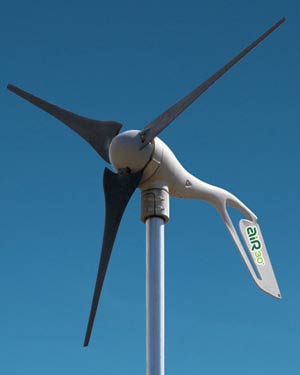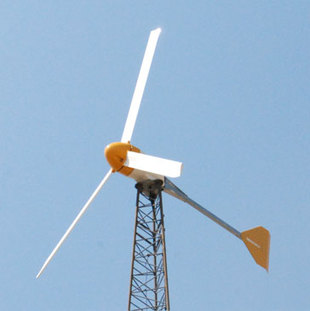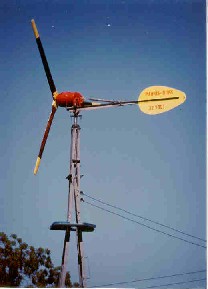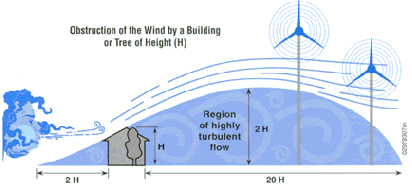<-----
Click here or on pictures
 |
 |
 |
 |
| AIR | BERGEY | USED | WHISPER |
Wind generators are used for battery charging, AC utility intertie, water or space heating and direct motor drive for water pumping. A typical system would have the wind generator on a tall tower (tilt-up, self-supporting, pipe or lattice), battery bank for storage, inverter to change DC to 120 volt AC. Depending on the type and size of inverter and wind system, the inverter can power all the loads, part of the loads or sell the surplus back to the utility company. Outputs will vary with wind speed, turbulence, blade diameter and generator size. An average wind speed of 8 mph or more is recommended for a battery charging system and 12 mph or more for a utility intertie system. Most wind generators will begin producing power at 7-10 mph and will reach full output at 25-30 mph. Air density will influence output. Hot temperatures or higher altitude lowers air density, which lowers power generated. Reduce expected output about 3% per 1000' above sea level. Wind generators are mounted at least 30' above nearby trees and buildings within a 300' radius. Tilt-up towers are nice because no climbing is needed. A wind generator, PV modules and Hydro electric unit can all be used to charge the same battery. The wind often blows on cloudy days when solar electric modules have low or no output.

A Primer on Small Turbines
by Michael Bergey,
Bergey Windpower Co.
The wind has been an important source of energy in the U.S. for a long time. The mechanical windmill was one of the two "high-technology" inventions (the other was barbed wire) of the late 1800's that allowed us to develop much of our western
frontier. Over 8 million mechanical windmills have been installed in the U.S. since the 1860's and some of these units have been in operation for more than a hundred years. Back in the 1920's and 1930's, before the REA began subsidizing rural electric coops and electric lines, farm families throughout the Midwest used 200-3,000 watt wind generators to power lights, radios, and kitchen appliances. The modest wind industry that had built up by the 1930's was literally driven out of business by government policies favoring the construction of utility lines and fossil fuel power plants.
In the late 1970's and early 1980's intense interest was once again focused on wind energy as a possible solution to the energy crisis. As homeowners and farmers looked to various electricity producing renewable energy alternatives, small wind turbines emerged as the most cost effective technology capable of reducing their utility bills. Tax credits and favorable federal regulations (PURPA) made it possible for over 4,500 small, 1-25 kW, utility-intertied wind systems to be installed at individual homes between 1976-1985. Another 1,000 systems were installed in various remote applications during the same
period. Small wind turbines were installed in all fifty States. None of the small wind turbine companies, however, were owned by large companies committed to long term market development, so when the federal tax credits expired in late 1985, and oil prices dropped to $10 a barrel two months later, most of the small wind turbine industry once again disappeared. The companies that survived this "market adjustment" and are producing small wind turbines today are those whose machines were the most reliable and whose reputations were the best.
The Cost Factor
Photovoltaics is an attractive technology in many ways, but cost is not one of them. Small wind turbines can be an attractive alternative, or addition, to those people needing more than 100-200 watts of power for their home, business, or remote facility. Unlike PV's, which stay at basically the same cost per watt independent of array size, wind turbines get less expensive with increasing system size. At the 50 watt size level, for example, a small wind turbine would cost about $8.00/watt compared to approximately $6.00/watt for a PV module. This is why, all things being equal, PV is less expensive for very small loads. As the system size gets larger, however, this "rule-of-thumb" reverses itself. At 300 watts the wind turbine costs are down to $2.50/watt ($1.50/watt in the case of the Southwest Windpower Air 403), while the PV costs are still at $6.00/watt. For a 1,500 watt wind system the cost is down to $2.00/watt and at 10,000 watts the cost of a wind generator (excluding electronics) is down to $1.50/watt. The cost of regulators and controls is essentially the same for PV and wind. Somewhat surprisingly, the cost of towers for the wind turbines is about the same as the cost of equivalent PV racks and trackers. The cost of wiring is usually higher for PV systems because of the large number of connections.
For homeowners connected to the utility grid, small wind turbines are usually the best "next step" after all the conservation and efficiency improvements have been made. A typical home consumes between 800-2,000 kWh of electricity per month and a 4-10 kW wind turbine or PV system is about the right size to meet this demand. At this size wind turbines are much less expensive.
Reliability
In the past reliability was the "Achilles Heel" of small wind turbine products. Small turbines designed in the late 1970's had a well deserved reputation for not being very reliable. Today's products, however, are technically advanced over these earlier units and they are substantially more reliable. Small turbines are now available that can operate 5 years or more, even at harsh sites, without need for maintenance or inspections and 5-year warranties are available. The reliability and cost of operation of these units is equal to that of photovoltaic systems.
Wind Energy
Wind energy is a form of solar energy produced by uneven heating of the Earth's surface. Wind resources are best along coastlines, on hills, and in the northern states, but usable wind resources can be found in most areas. As a power source wind energy is less predictable than solar energy, but it is also typically available for more hours in a given day. Wind resources are influenced by terrain and other factors that make it much more site specific than solar energy. In hilly terrain, for example, you and your neighbor are likely to have the exact same solar resource. But you could have a much better wind resource than your neighbor because your property is on top of the hill or it has a better exposure to the prevailing wind direction. Conversely, if your property is in a gully or on the leeward side of the hill, your wind resource could be substantially lower. In this regard, wind energy must be considered more carefully than solar energy.
Wind energy follows seasonal patterns that provide the best performance in the winter months and the lowest performance in the summer months. This is just the opposite of solar energy. For this reason wind and solar systems work well together in hybrid systems. These hybrid systems provide a more consistent year-round output than either wind-only or PV-only systems. One of the most active market segments for small wind turbine manufacturers is PV-only system owners who are expanding their system with wind energy.
Wind Turbines
Most wind turbines are horizontal-axis propeller type systems. Vertical-axis systems, such as the the egg-beater like Darrieus and S-rotor type Savonius type systems, have proven to be more expensive. A horizontal-axis wind turbine consists of a rotor, a generator, a mainframe, and, usually, a tail. The rotor captures the kinetic energy of the wind and converts it into rotary motion to drive the generator. The rotor usually consists of two or three blades. A three blade unit can be a little more efficient and will run smoother than a two blade rotor, but they also cost more. The blades are usually made from either wood or fiberglass because these materials have the needed combination of strength and flexibility (and they don't interfere with television signals!).
The generator is usually specifically designed for the wind turbine. Permanent magnet alternators are popular because they eliminate the need for field windings. A low speed direct drive generator is an important feature because systems that use gearboxes or belts have generally not been reliable. The mainframe is the structural backbone of the wind turbine and it includes the "slip-rings" that connect the rotating (as it points itself into changing wind directions) wind turbine and the fixed tower wiring. The tail aligns the rotor into the wind and can be a part of the overspeed protection.
A wind turbine is a deceptively difficult product to develop and many of the early units were not very reliable. A PV module is inherently reliable because it has no moving parts and, in general, one PV module is as reliable as the next. A wind turbine, on the other hand, must have moving parts and the reliability of a specific machine is determined by the level of skill used in its engineering and design. In other words, there can be a big difference in reliability, ruggedness, and life expectancy from one brand to the next. This is a lesson that often seems to escape dealers and customers who are used to working with solar modules.
Towers
A wind turbine must have a clear shot at the wind to perform efficiently. Turbulence, which both reduces performance and "works" the turbine harder than smooth air, is highest close to the ground and diminishes with height. Also, wind speed increases with height above the ground. As a general rule of thumb, you should install a wind turbine on a tower such that it is at least 30 ft above any obstacles within 300 ft. Smaller turbines typically go on shorter towers than larger turbines. A 250 watt turbine is often, for example, installed on a 30-50 ft tower, while a 10 kW turbine will usually need a tower of 80-120 ft. We do not recommend mounting wind turbines to small buildings that people live in because of the inherent problems of turbulence, noise, and vibration.
The least expensive tower type is the guyed-lattice tower, such as those commonly used for ham radio antennas. Smaller guyed towers are sometimes constructed with tubular sections or pipe. Self-supporting towers, either lattice or tubular in construction, take up less room and are more attractive but they are also more expensive. Telephone poles can be used for smaller wind turbines. Towers, particularly guyed towers, can be hinged at their base and suitably equipped to allow them to be tilted up or down using a winch or vehicle. This allows all work to be done at ground level. Some towers and turbines can
be easily erected by the purchaser, while others are best left to trained professionals. Anti-fall devices, consisting of a wire with a latching runner, are available and are highly recommended for any tower that will be climbed. Aluminum towers should be avoided because they are prone to developing cracks. Towers are usually offered by wind turbine manufacturers and purchasing one from them is the best way to ensure proper compatibility.
Remote Systems Equipment
The balance-of-systems equipment used with a small wind turbine in a remote application is essentially the same as used with a PV system. Most wind turbines designed for battery charging come with a regulator to prevent overcharge. The regulator is specifically designed to work with that particular turbine. PV regulators are generally not suitable for use with a small wind turbine because they are not designed to handle the voltage and current variations found with turbines. The output from the regulator is typically tied into a DC source center, which also serves as the connection point for other DC sources, loads and the batteries. For a hybrid system the PV and wind systems are connected to the DC source center through separate regulators, but no special controls are generally required. For small wind turbines a general rule-of-thumb is that the AH capacity of the battery bank should be at least six times the maximum renewables charging current, including any PV
elements. The wind industry has had good experience using battery banks that are smaller than those typically recommended for PV applications.
Being Your Own Utility Company
The federal PURPA regulations passed in 1978 allow you to interconnect a suitable renewable energy powered generator to your house or business to reduce your consumption of utility supplied electricity. This same law requires utilities to purchase
any excess electricity production at a price (avoided cost) usually below the retail cost of electricity. In about a half-dozen states with "net energy billing options" small systems are allowed to run the meter backwards, so they get the full retail rate for excess production. Because of the high overhead costs to the utilities for keeping a few special hand-processed customer accounts, net energy billing is actually less expensive for them.
These systems do not use batteries. The output of the wind turbine is made compatible with utility power using either a line-commutated inverter or an induction generator. The output is then connected to the household breaker panel on a dedicated breaker, just like a large appliance. When the wind turbine is not operating, or it is not putting out as much electricity as the house needs, the additional electricity needed is supplied by the utility. Likewise, if the turbine puts out more power than the house needs, the excess is instantaneously "sold" to the utility. In effect, the utility acts as a very big battery bank and the utility "see's" the wind turbine as a negative load. After over 200 million hours of interconnected operation we now know that small utility-interconnected wind turbines are safe, do not interfere with either utility or customer equipment, and do not need any special safety equipment to operate successfully.
Hundreds of homeowners around the country who installed 4-12 kW wind turbines during the go-go tax credit days in the early 1980's now have everything paid for and enjoy monthly electrical bills of $8-30, while their neighbors have bills in the range of $100-200 per month. The problem, of course, is that these tax credits are long gone and without them most homeowners will find the cost of a suitable wind generator prohibitively expensive. A 10 kW turbine (the most common size for homes), for example, will typically cost $28,000-35,000 installed. For those paying 12 cents/kilowatt-hour or more for
electricity in an area with an average wind speed of 10 mph or more (DOE Class 2), and with an acre or more of property (the turbines are big), a residential wind turbine is certainly worth considering. Payback periods will generally fall in the range of 8-16 years and some wind turbines are designed to last thirty years or more.
Performance
The rated power for a wind turbine is not a good basis for comparing one product to the next. This is because manufacturers are free to pick the wind speed at which they rate their turbines. If the rated wind speeds are not the same then comparing the two products is very misleading. Fortunately, the American Wind Energy Association has adopted a standard method of rating energy production performance. Manufacturers who follow the AWEA standard will give information on the Annual Energy Output (AEO) at various annual average wind speeds. These AEO figures are like the EPA Estimated Gas Mileage for your car, they allow you to compare products fairly, but they don't tell you just what your actual performance will be ("Your Performance May Vary").
Wind resource maps for the U.S. have been compiled by the Department of Energy. These maps show the resource by "Power Classes" that mean the average wind speed will probably be within a certain band. The higher the Power Class the better the resource. We say probably because of the terrain effects mentioned earlier. On open terrain the DOE maps are quite good, but in hilly or mountainous terrain they must be used with great caution. The wind resource is defined for a standard wind sensor height of 33 ft (10 m), so you must correct the average wind speed for wind tower heights above this height before using the AEO information supplied by the manufacturer. Wind turbine performance is also usually derated for altitude, just like an airplane, and for turbulence. Wind turbine manufacturers can usually provide computer-aided performance predictions for their turbines at virtually any site.
As a rule of thumb wind energy should be considered if your average wind speed is above 8 mph (most, but not all, Class 1 and all other Classes) for a remote application and 10 mph (Class 2 or better) for a utility-intertied application. If you live in an area that is not too hilly then the DOE wind resource map can be used to fairly accurately calculate the expected performance of a wind turbine at your site. In complex terrain a judgment on the site's exposure must be made to adjust the average wind speed used for this calculation. In most situations it is not necessary to monitor the wind speed with a recording
anemometer prior to installing a small wind turbine. But in some situations it is worth spending $300-1,000 and waiting a year to perform a wind survey. Manufacturers and equipment dealers can help sort out these questions.
Books
By far the best source of general information on the technology and application of small wind turbines is a book written by Paul Gipe. Mr. Gipe has more than 20 years experience with small wind systems and is a world renowned author and lecturer on the subject. This book, Wind Power for Home & Business, is soft-bound and a little over 400 pages long. Gipe's book is easy to read and is filled with examples, illustrations, and a lot of common sense. We highly recommend it.
(See our book section)
Keeping Current
The best way to keep current with the progress of wind energy development, both
small and large scale, in the U.S. is to join the:
American Wind Energy Association
122 C St., NW, 3rd Floor
Washington, DC 20001
Tel: 202-383-2500
Fax:202-383-2505